new posts in all blogs
Viewing: Blog Posts Tagged with: teaching resources, Most Recent at Top [Help]
Results 1 - 25 of 30
How to use this Page
You are viewing the most recent posts tagged with the words: teaching resources in the JacketFlap blog reader. What is a tag? Think of a tag as a keyword or category label. Tags can both help you find posts on JacketFlap.com as well as provide an easy way for you to "remember" and classify posts for later recall. Try adding a tag yourself by clicking "Add a tag" below a post's header. Scroll down through the list of Recent Posts in the left column and click on a post title that sounds interesting. You can view all posts from a specific blog by clicking the Blog name in the right column, or you can click a 'More Posts from this Blog' link in any individual post.

By: Guest Blogger,
on 10/21/2016
Blog:
First Book
(
Login to Add to MyJacketFlap)
JacketFlap tags:
Literacy,
Education,
Sesame Street,
teaching resources,
Guest Blog Posts,
early childhood education,
education technology,
joan ganz cooney,
Michael Levine,
new america,
Opportunities for You,
Using First Book,
Using the First Book Marketplace,
The First Book Marketplace,
How to Use First Book Resouces,
campaign for grade level reading,
digital reading resources,
Lisa Guernsey,
tap click read,
Add a tag

The following is a guest blog post from Michael H. Levine & Lisa Guernsey, authors of the book Tap, Click, Read.
Kids today use a wide variety of tools to learn. How do educators adapt teaching tactics to effectively use modern day tools?
New America and the Joan Ganz Cooney Center at Sesame Workshop have become known for our joint research and analysis on how digital technologies could be used to improve, instead of impede, early literacy. We have collaborated on the book Tap, Click, Read and developed a toolkit designed to help educators put these insights into practice. The Tap, Click, Read toolkit – comprised of fourteen research-based resources including tipsheets, discussion guides, ratings lists, and a quiz—are now downloadable for free on the First Book Marketplace.
On the First Book Marketplace you’ll find resources for educators, caregivers, and community leaders:
- What Educators Can Do—A list of recommendations for updating teaching methods, working with libraries and public media, and more.
- What Parents Can Do—A list of ideas for parents and caregivers, including the importance of listening to and talking with children about the media they use and why.
- How to Use Media to Support Children’s Home Language—Used well, media can spark opportunities for children to converse with their family members at home in their native languages. This helps them build a foundation for learning English too.
- How to Promote Creation and Authorship—Children need to learn what it means to be a creator, not just a consumer, of media. New tools bring this concept to life.
- How to Find Apps for Literacy Learning—Choose wisely. Use app-review sites and advice from literacy experts to find materials that match your students’ needs.
- The Three C’s—Content, context, and the individual child. Become more mindful in using digital technology with young children by taking this quiz.
- A Modern Action Plan for States and Communities—A guide for community and state leaders on how to make progress in solving America’s reading crisis and strengthening family-centered approaches that will endure over time.
- 12 Actions to Take Now—A one-page list of “must-dos” for community leaders, district administrators, and policymakers to break out of the literacy crisis and bring opportunities to all children.
We are so proud to team up with First Book to provide the children you serve with access to quality 21st-century literacy opportunities. Click here to learn more about our partnership, and visit the Joan Ganz Cooney Center blog for more resources that guide learning through digital tools – including bilingual video vignettes and discussion guides.
The post “Tap, Click, Read” Toolkit – Promoting Early Literacy in a World of Screens appeared first on First Book Blog.


By: JOANNA MARPLE,
on 4/22/2016
Blog:
Miss Marple's Musings
(
Login to Add to MyJacketFlap)
JacketFlap tags:
children's books,
trees,
National Parks,
conservation,
National geographic Kids,
teaching resources,
photogarphy,
Perfect Picture Book Friday,
Earth Day 2016,
National Parks Centennial edition,
Add a tag
Title: National Geographic Kids National Park Guides U.S.A
Written by: Sarah Wassener Flynn and Julie Beer
Published by: National Geographic Kids, 2016
Themes: national parks in the USA, sights, activities, trips, conservation
Ages: 7- adult
Opening:
In the last hundred years, life in the Unites States has changed a lot, … Continue reading →
Title: The Thing About Yetis
Author & Illustrator: Vin Vogel
Publisher: Dial Books for Young Readers, 2015
Themes: winter, yetis, summer
Ages: 3-5
Opening:
The thing about yetis is that yetis love winter
Synopsis:
Everyone knows yetis love winter. They love snowball fights and hot chocolate and sledding. But even yetis … Continue reading →
Title: Peddles
Author & Illustrator: Elizabeth Rose Stanton
Publisher: Paula Wiseman Book, Simon & Schuster, 2016
Themes: pigs, dreams, dancing
Ages: 3-7
Opening:
Peddles was just a pig.
He lived on a farm with other pigs, doing the usual pig things:
eating and sleeping
and oinking and rooting
and wallowing
and…
Synopsis:
Have you ever been … Continue reading →

By: JOANNA MARPLE,
on 1/15/2016
Blog:
Miss Marple's Musings
(
Login to Add to MyJacketFlap)
JacketFlap tags:
Meg Medina,
Perfect Picture Book Friday,
WNDB,
Diversity Day 2016,
Belpre (Author) Honor Books 2016,
Mango Abuela and Me,
Book recommendation,
Spanish,
grandmothers,
teaching resources,
language learning,
Angela Dominguez,
Add a tag
Title: Mango, Abuela and Me
Author: Meg Medina
Illustrator: Angela Dominguez
Publisher: Candlewick Press, 2015
Themes: love, learning new language, making friends
Awards: Belpre (Author and illustrator) Honor Books, 2016
Ages: 3-7
Opening:
SHE COMES TO US in winter, leaving behind her sunny house that rested between two snaking rivers. … Continue reading →

By: JOANNA MARPLE,
on 12/4/2015
Blog:
Miss Marple's Musings
(
Login to Add to MyJacketFlap)
JacketFlap tags:
photos,
poetry,
homeschooling,
Joseph Bruchac,
Book recommendation,
National geographic,
Laura Purdie Salas,
Emily Dickenson,
Billy Collins,
Rebecca kai Dotlich,
teaching resources,
Perfect Picture Book Friday,
Renee LaTulippe,
book of nature poetry,
elementary classrooms,
J Patrick Lews,
World Wildlife Conservation Day,
Add a tag
I confess to changing my choice today to Perfect Poetry Book Friday, but with good reason. This book deserves wide promotion and it fits perfectly into the aims of our blogging group to recommend high quality books with pictures for … Continue reading →
Title: DIRTMEISTERS, Nitty Gritty Planet Earth
Written by: Geologist Steve Tomecek
Illustrated by: Fred Harper
Published by: National Geographic Kids, 2015
Themes/Topics: geology, the Earth, rocks, earthquakes, fossils, evolution, experiments, scientists
Suitable for ages: 8-14
Opening:
Dirtmeister is a nickname I picked up a long time ago because … Continue reading →

By: JOANNA MARPLE,
on 9/4/2015
Blog:
Miss Marple's Musings
(
Login to Add to MyJacketFlap)
JacketFlap tags:
picture books,
zebra,
shapes,
Book recommendation,
moose,
Kelly Bingham,
teaching resources,
Wiesner,
pinterest,
Perfect Picture Book Friday,
Paul O'Zelinsky,
Circle Square Moose,
carolyn chao,
Add a tag
Title: CIRCLE SQUARE MOOSE Written by: Kelly Bingham Illustrated by: Paul O. Zelinsky Published by: Harper Collins Children’s Books, 2014 Themes/Topics: shapes, moose, zebra, friendship Suitable for ages: 3-7 Opening: Shapes are all around us. We see them every day. Have you ever looked … Continue reading →

By: JOANNA MARPLE,
on 4/10/2015
Blog:
Miss Marple's Musings
(
Login to Add to MyJacketFlap)
JacketFlap tags:
teaching resources,
oceanography,
Perfect Picture Book Friday,
Claire A Nivola,
female marine biologists,
LIFE IN THE OCEAN THE STORY OF OCEANOGRAPHER SYLVIA EARLE,
perfect lci,
biography,
picture books,
Add a tag
Title: Life in the Ocean, The Story of Oceanographer SYLVIA EARLE Written by and illustrated by: Claire A. Nivola Published in Canada by: D&M Publishers, Inc., 2012 Themes/Topics: women marine biologists, biography, women explorers, the ocean Suitable for ages: 7-11 Opening: Seen from … Continue reading →

By:
vschneider46,
on 3/9/2015
Blog:
The Open Book
(
Login to Add to MyJacketFlap)
JacketFlap tags:
teaching,
education,
technology,
science,
social studies,
mathematics,
Educators,
teaching resources,
STEM,
instruction,
common core,
educator activities,
English instruction,
Educator Resources,
Common Core State Standards,
classroom resources,
Add a tag
Think there’s no need for sepia-toned filters and hashtags in your classroom? Don’t write off the world of #selfies just yet.
Instagram is one of the most popular social media channels among generation Z, or those born after 1995 and don’t know a world without the Internet. It shouldn’t come as much of a surprise that this is a generation of visual learners and communicators, where sharing your life-from the food you’re about to eat to your thoughts about anything and everything-is a part of your everyday routine. So, why allow Instagram in your classroom?
For starters, preparing students to be college and career ready involves helping them build their digital literacy skills on a professional level, and Instagram is a technological tool that offers educators innovative ways to motivate and engage students, opening up a new platform for collaboration, research, and discussion. Secondly, we all know the importance of interest and ownership for getting students excited about learning, and since your students probably already love Instagram you’ve already won half the battle.
Teacher/Classroom Instagram Accounts
Create a private classroom Instagram account that you control and  can use to connect with your students, their parents and guardians, and other grade team members. Invite them to follow your account and catch a glimpse of your everyday classroom moments and adventures.
can use to connect with your students, their parents and guardians, and other grade team members. Invite them to follow your account and catch a glimpse of your everyday classroom moments and adventures.
- Student of the Week: Each week, feature a different student on the class Instagram account, posting photos-with their permission- of their favorite classroom projects and other examples of their hard work and achievement. This is a fun opportunity to highlight your students’ individual strengths, positively reinforcing their behavior and progress.
- Daily/Weekly Classroom Update: Similar to student of the week, you can instagram your students’ classroom projects and activities on a daily or weekly basis. From photos of new classroom reads to capturing field trip memories, this is an excellent way to build a sense of community while allowing parents to see what lessons, topics, and exciting activities are happening in your classroom. This is also a great way to easily and quickly share your classroom ideas with other grade team teachers.
- Student takeover: If you’re not able to encourage students to create their own individual Instagram accounts, invite each student to “take over” the classroom account for a day or week by sharing photos from his or her everyday life. This is a great opportunity for students to learn more about their peers by instagramming their interests, hobbies, routines, and even cultural traditions.
- Photo Inspiration: Finding inspiration to write can be one of the most difficult parts of the writing process. Spark your students’ imaginations and help them discover new ideas through instagramming writing prompts by playing with different angles, perspectives, and filters to capture random moments and objects that you encounter throughout your day-to-day.
- Caption That! For a variation of the writing prompt, post an interesting photo and ask your students to write a descriptive caption in the comments. Differentiate how challenging this task is by asking students to write their caption using specific sentence types, different parts of speech, clauses, prepositional phrases, and their current vocabulary words.
- Daily challenges: If your students are able to follow the classroom Instagram account on a regular basis, you can use it to post daily challenges in the form of visual word problems, review questions, and bonus questions. Instagram photos of important learned concepts and pose questions to your students in the caption, asking them to write their answers in the comments. For example, this fifth-grade teacher used Instagram to review who Henry Ford was and other important events in history.
Student Instagram Accounts
Asking your students to follow the classroom Instagram account with their personal accounts is one, highly unlikely, and two, probably not the best idea. What you can do is ask your students to create additional Instagram accounts that would only be used for school or classroom purposes. You know how LinkedIn is your professional Facebook? A similar idea applies here.
- A Day in the Life: Challenge students to assume the role of a
 fictional literary character and share images that he or she believes the specific character would post, highlighting the character’s interests, personality traits, and development throughout the story. The 15-second video option is a great way to really let students get into character through recorded role-playing and even performance reenactments. These activities can also be applied to important figures in history, such as the creator of Honda, Soichiro Honda, or jazz musician, Melba Liston.
fictional literary character and share images that he or she believes the specific character would post, highlighting the character’s interests, personality traits, and development throughout the story. The 15-second video option is a great way to really let students get into character through recorded role-playing and even performance reenactments. These activities can also be applied to important figures in history, such as the creator of Honda, Soichiro Honda, or jazz musician, Melba Liston.
- What the Kids are Reading: Students can snap photos of their favorite reads and write a brief 1-5 sentence review in the caption. To take it a step further, ask them to record 15-second long persuasive book trailers to hook their peers. Boost further discussion among your students by asking them to comment on other book reviews and book trailer videos to share their opinions. Tip: Encourage your students to use a unique #hashtag (ex.: #SMSGrade4Reads) for each book review posted, and by the end of the year you will have a visual library of all of the books your class has read.
- Math Hunt: “Why do we have to learn this?” “I won’t need this in my everyday life.” Sound familiar? Help your students see the real-world math applications all around them by sending them on a hunt to document or illustrate their knowledge of different math concepts:
- Geometry: lines (parallel, perpendicular, and intersecting), angles (right, acute, obtuse, etc.) symmetry, and three-dimensional shapes (prisms, cubes, cylinders, etc.)
- Everyday fractions and arrays
- Concepts of money
- Examples of volume vs. mass, area vs. perimeter
- STEM Research: Students can watch, observe, and record science experiment data and results over time by documenting any step-by-step process with photo and video narration of learned science concepts. Outside of the lab, students can use their Instagram accounts for observing science in nature or sharing their own scientific findings. What makes this special is how quickly and easily students can share and revisit their visual references and recorded data.
- Physical & chemical changes
- Weather patterns and phases of the moon
- Animal adaptations
- Habitats in nature
Note: Instagram, as well as Facebook, Twitter, Pinterest, Tumblr, and Snapchat, has a minimum age limit of 13 to open an account, but according to Instagram’s parents’ guide, there are many younger users on Instagram with their parents’ permission since you don’t have to specify your age. Always check with your school’s administrator and obtain parental permission before sharing photos of students or their work.
Know of any other interesting ways to use Instagram or other social media sites in the classroom? Already using Instagram in the classroom? Let us know in the comments!
 Veronica has a degree from Mount Saint Mary College and joined LEE & LOW in the fall of 2014. She has a background in education and holds a New York State childhood education (1-6) and students with disabilities (1-6) certification. When she’s not wandering around New York City, you can find her hiking with her dog Milo in her hometown in the Hudson Valley, NY.
Veronica has a degree from Mount Saint Mary College and joined LEE & LOW in the fall of 2014. She has a background in education and holds a New York State childhood education (1-6) and students with disabilities (1-6) certification. When she’s not wandering around New York City, you can find her hiking with her dog Milo in her hometown in the Hudson Valley, NY.

By: JOANNA MARPLE,
on 2/27/2015
Blog:
Miss Marple's Musings
(
Login to Add to MyJacketFlap)
JacketFlap tags:
stuttering,
Perfect Picture Book Friday,
Award Winning Picture Book Reviews,
Diversity Reading Challenge 2015,
A Boy And A Jaguar,
PANTHERA,
picture books,
cats,
conservation,
teaching resources,
jaguars,
Add a tag
Title: A Boy And A Jaguar Written by: Alan Rabinowitz Illustrated by: Catia Chien Published by: Houghton Mifflin Harcourt, 2014 Themes/Topics: jaguars, conservation, stuttering, big cats Suitable for ages: 3-7 Awards: Schneider Family Book Award for Children (2015) Autobiographical Opening: I’m standing in … Continue reading →

By: JOANNA MARPLE,
on 2/20/2015
Blog:
Miss Marple's Musings
(
Login to Add to MyJacketFlap)
JacketFlap tags:
I know a Bear,
Mariana Ruiz Johnson,
picture books,
activities,
bears,
teaching resources,
empathy,
zoos,
Perfect Picture Book Friday,
Add a tag
Title: I Know a Bear Written and illustrated by: Mariana Ruiz Johnson Published by: Schwarz & Wade Books, 2014 (originally published in France as J’ai un Ours by Editions Gallimard Jeunesse, Paris, 2011) Themes/Topics: zoo animals, bears, listening Suitable for ages: 3-7 Opening: I know a bear … Continue reading →

By: JOANNA MARPLE,
on 12/5/2014
Blog:
Miss Marple's Musings
(
Login to Add to MyJacketFlap)
JacketFlap tags:
picture books,
Ape,
bonobo,
homo sapiens,
teaching resources,
Great apes,
gorillas,
orangutan,
Martin Jenkins,
chimpanzees,
Vicky White,
Perfect Picture Book Friday,
THE ONE AND ONLY IVAN,
Picture Book Perfect,
PPBF,
Add a tag
Title: Ape Written by: Martin Jenkins Illustrated by: Vicky White Published by: Candlewick, 2007 Themes/Topics: five categories of great apes, humans Suitable for ages: 4-8 Non Fiction, 32 pages Opening: There are five kinds of great apes in the world. Each of them is different … Continue reading →
Differentiated, or tiered, assignments provide students opportunities for individual understanding and growth in learning.  Activities, projects, and tasks that educators create for their students can be used with flexible groups to address common learning needs.
Activities, projects, and tasks that educators create for their students can be used with flexible groups to address common learning needs.
Based on students’ diverse needs, educators differentiate by manipulating one or more of the following: content (what students learn), process (how students learn it), and product (what students create to demonstrate their learning).
Within those three domains, educators can differentiate based on challenge, complexity, resources, process, and product. We will tackle 5 ways to differentiate assignments using the Adventures Around the World series by Ted and Betsy Lewin.
Differentiate by Challenge Level:
We use Bloom’s Taxonomy as a guide to develop instructional tasks with differing degrees of challenging demands. Based on the rigor and complexity of what is being taught, we can design and categorize assignments using the following classifications from Bloom’s levels of higher thinking: recall, understand, apply, analyze, evaluate, and create.
Example: Top to Bottom: Down Under
Recall: List the different types of wildlife that live in northern and southern Australia, and classify them as mammals, reptiles, birds, amphibians, or fish.
Understand: Identify and explain the adaptations of the platypus or echidna in their habitats.
Create: Design a new Australian animal incorporating the characteristics of two animal classifications (mammal, reptile, amphibian, bird, fish) and a written explanation supporting your reasons.
Differentiate by Complexity:
Increasing the complexity of an assigned task involves differentiating the content, or an introductory vs a more advanced activity focus. This involves strategically developing learning objectives and understanding what students should be able to do. Again, Bloom’s Taxonomy can help guide the development of least, more, and most complex tasks for your students.
In the following example, all of the students are required to write an informational essay, but the lens of their research differs in complexity.
Example: Horse Song: The Naadam of Mongolia
Least complex: Write an informational essay about the tradition of the Naadam horse racing in Mongolia.
More complex: Write an informational essay about the tradition of the Naadam horse racing in Mongolia and evaluate the pros and cons.
Most complex: Write an informational essay about the tradition of the Naadam horse racing in Mongolia and determine your opinion, presenting a convincing argument either for or against the horse races.
Differentiate by Resource:
Differentiating by resource should be approached with thoughtful consideration of students. This requires thinking about their reading strengths and needs, as well as students’ interest in and prior knowledge about a topic. Differentiating by resource may involve selecting supplementary reading materials, such as articles, magazines, and primary documents, and using visual aids, including videos, charts, and graphic organizers. Offering all students opportunities to engage with different resources and assigning age-appropriate materials to groups of students supports collaboration and inclusion of readers of all levels.
Example: Gorilla Walk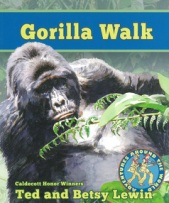
Lower-level readers: Provide supplementary informational texts or materials about the endangered mountain gorilla on a lower reading level, such as a pre-reading guide/outline for Gorilla Walk, an audio recording of Gorilla Walk to listen to as students read along, or a graphic organizer to record notes as students read.
Advanced readers: Provide challenging supplementary articles or texts about the endangered mountain gorilla or animal habituation and critical-thinking questions to answer as students read the text.
Differentiate by Process:
When students are expected to achieve similar outcomes, such as understanding new vocabulary words, teachers often differentiate assignments by how students will achieve expected learning objectives. Therefore, how students engage with the content involves considering how challenging and complex the process or strategy is for the student, as well as offering varying and supplementary resources.
Example: Elephant Quest
Vocabulary words: delta, protrude, submerge, matriarch, bounding, intent, emerge
- Frayer Model: Students will use the Frayer model to: define the word in their own words, list essential characteristics of the word/concept, and provide both examples and nonexamples.
- LINCS strategy: (on an index card)
L: List the word + definition
I: Identify a reminding word
N: Note a LINCing story
C: Create a LINCing picture
S: Self-test
Differentiate by Product:
When students are all provided with the same materials, educators may decide to differentiate the assignment by outcom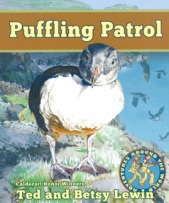 e, or what students are expected to be able to do in order to demonstrate gained knowledge. Differentation by product is valuable in encouraging student success and practice in other areas of thinking and learning.
e, or what students are expected to be able to do in order to demonstrate gained knowledge. Differentation by product is valuable in encouraging student success and practice in other areas of thinking and learning.
Example: Puffling Patrol
Visual/Spatial: Create an informational video advertisement persuading people to join the Puffling Patrol on the island of Heimaey.
Verbal/Linguistic: Create an informational brochure persuading people to join the Puffling Patrol on the island of Heimaey.
For further reading on differentiation:
- 5 Harmful Differentiation Myths: Part 1
- Heacox, D. (2012). Differentiating instruction in the regular classroom: How to reach and teach all learners. Minneapolis, MN: Free Spirit Publishing, Inc.
 Veronica has a degree from Mount Saint Mary College and joined LEE & LOW in the fall of 2014. She has a background in education and holds a New York State childhood education (1-6) and students with disabilities (1-6) certification. When she’s not wandering around New York City, you can find her hiking with her dog Milo in her hometown in the Hudson Valley, NY.
Veronica has a degree from Mount Saint Mary College and joined LEE & LOW in the fall of 2014. She has a background in education and holds a New York State childhood education (1-6) and students with disabilities (1-6) certification. When she’s not wandering around New York City, you can find her hiking with her dog Milo in her hometown in the Hudson Valley, NY.
Filed under:
Common Core State Standards,
Educator Resources Tagged:
Educators,
ELA common core standards,
literacy,
teaching resources 

The learning differences, preferences, and varied backgrounds existent in the classroom present teachers with a challenging task: help every student become a successful learner. How can teachers support all students’ diverse needs? Much confusion and fear have surrounded differentiated instruction and its use in the classroom.
task: help every student become a successful learner. How can teachers support all students’ diverse needs? Much confusion and fear have surrounded differentiated instruction and its use in the classroom.
Myth #1: Differentiation = Individualization
Differentiation doesn’t mean individualizing the curriculum for each student. Yes, when teachers meet one-on-one and conference with students, modifying instruction to best suit the student’s needs, both individualization and differentiation are taking place. However, writing an individual lesson plan for every student in the classroom is NOT differentiating (it’s insanity). Instead, differentiation involves using quality and effective instructional practices to strategically address groups of students based on various levels of learning readiness, interests, and learning styles.
 Myth #2: Every student should be doing something different
Myth #2: Every student should be doing something different
Teachers should consider each student’s strengths and areas that need support, but that does not mean 30 students are engaged in 30 different activities. Instead, teachers use differentiation to provide a range of activities and assignments that challenge and offer variety in students’ learning opportunities. This includes flexible grouping, or organizing students by ability, learning styles, and academic needs. Students may work individually, in pairs, collaborative groups, or as a class based on learning objectives and their individual needs and preferences. For example, one group may be practicing math skill fluency while another group is applying this skill within more challenging settings. Differentiation also involves modifying the content (the what), process (the how), and product (the end result). Using assessment to inform instruction, providing leveled reading books, increasing or decreasing task complexity, and assigning tasks based on visual, auditory, and kinesthetic learning preferences all support such differentiated learning opportunities.
Myth #3: Test prep doesn’t allow you to differentiate
Differentiation’s first objective is to help students deeply understand the content. This is essential to encourage the progressive achievement of a desired level of mastery in preparation for students’ successful careers and futures. Differentiated instruction better prepares students for standardized tests through authentic learning experiences that exercise higher-order, critical thinking skills and encourage the development of strong conceptual understanding. Secondly, differentiation aims to prepare students for varied forms of assessment, including group projects and research papers, as well as multiple-choice questions on a standardized test. Therefore, using standardized testing preparation to assess and monitor students’ progress and understanding is important, but it is only one of the many types of assessment teachers use. Undifferentiated or standardized assessments should be provided along with authentic and performance-based assessments.
Myth #4: There is no time to differentiate
Differentiation doesn’t have to be thought of as separate from instruction. The key is to treat differentiation as a core part of the lesson and unit plan, rather than as an afterthought. The best answer is to start small, such as differentiating one subject or unit at a time by modifying the plans and materials you already have. Even though a teacher may feel he/she has little control over the content, differentiating instruction can support how he/she will teach it.
Myth #5: Differentiation is the end-all-be-all solution for academic achievement
Differentiation is one way to help all students of varying abilities, learning styles, interests, and background experiences meet or exceed grade-level expectations. Parent engagement, assessment, reflection, professional development, and content and grade-level collaboration are all part of the toolbox schools and teachers need to proactively anticipate and appropriately respond to students’ continuously changing needs.
What does differentiation look like in action? This is Part 1 of 2 posts about differentiation and how it is used in the classroom.
Cash, R. M. (2011). Advancing differentiation: Thinking and learning for the 21st century. Minneapolis, MN: Free Spirit Publishing, Inc.
 Veronica has a degree from Mount Saint Mary College and joined LEE & LOW in the fall of 2014. She has a background in education and holds a New York State childhood education (1-6) and students with disabilities (1-6) certification. When she’s not wandering around New York City, you can find her hiking with her dog Milo in her hometown in the Hudson Valley, NY.
Veronica has a degree from Mount Saint Mary College and joined LEE & LOW in the fall of 2014. She has a background in education and holds a New York State childhood education (1-6) and students with disabilities (1-6) certification. When she’s not wandering around New York City, you can find her hiking with her dog Milo in her hometown in the Hudson Valley, NY.
Filed under:
Common Core State Standards,
Educator Resources Tagged:
CCSS,
Educators,
ELA common core standards,
guided reading,
teaching resources 


By: JOANNA MARPLE,
on 11/7/2014
Blog:
Miss Marple's Musings
(
Login to Add to MyJacketFlap)
JacketFlap tags:
picture book,
picture books,
nature,
trees,
Book recommendation,
sisters,
teaching resources,
making up,
Perfect Picture Book Friday,
Lori Nichols,
actiivities,
Maple & Willow Together,
pig latin,
sibling bond,
Add a tag
Title: Maple & Willow Together Written and illustrated by: Lori Nichols Published by: Nancy Paulsen Books, Nov. 4th, 2014 Themes/Topics: sisters, sibling dynamics, making up Suitable for ages: 3-7 Fiction, 32 pages Opening: Maple and her little sister, Willow, were always together. … Continue reading →

By: JOANNA MARPLE,
on 10/24/2014
Blog:
Miss Marple's Musings
(
Login to Add to MyJacketFlap)
JacketFlap tags:
HERE COMES SANTA CAT,
cats,
Christmas,
picture book review,
teaching resources,
Deborah Underwood,
being nice,
Perfect Picture Book Friday,
Claudia Rueda,
Add a tag
Title: Here Comes Santa Cat Written by: Deborah Underwood Illustrated by: Claudia Rueda Published by: Dial Books for Young Readers, Oct 21st, 2014 Suitable for ages: 3-7 Themes: cats, being nice, Christmas, Santa Fiction, small format, 80 pages Opening Lines: … Continue reading →
This is the fifth picture book illustrated by Wendell Minor that I have reviewed! It has just recently been published and I thought it would be a great follow-on from last week’s review on A GRAND OLD TREE. It is, after … Continue reading →
Title: Wild About Bears By Jeannie Brett Published by Charlesbridge, March 2014 Ages: 6-9 Themes: Bears Nonfiction Opening Lines: Eight bear species live on earth today: the polar bear, brown bear, North American black bear, spectacled bear, Asiatic black bear, sloth … Continue reading →

By:
Hannah,
on 4/12/2014
Blog:
The Open Book
(
Login to Add to MyJacketFlap)
JacketFlap tags:
Latino/Hispanic/Mexican,
Día de los niños/Día de los libros,
Curriculum Corner,
English-Spanish,
libros en Español,
Reading Aloud,
parents,
bilingual books,
Read Aloud,
guest blogger,
ell,
bilingual,
teaching resources,
bilingual education,
reading comprehension,
Add a tag

Jennifer Brunk has been teaching Spanish and English learners from preschool to university level for over 20 years. She re sides in Wisconsin where she raised her three children speaking Spanish and English. Jennifer blogs about resources for teaching Spanish to children on Spanish Playground. The following post is reprinted with permission from her original post at Spanish Playground.
sides in Wisconsin where she raised her three children speaking Spanish and English. Jennifer blogs about resources for teaching Spanish to children on Spanish Playground. The following post is reprinted with permission from her original post at Spanish Playground.
Research has shown that reading to children helps them learn vocabulary and improves listening comprehension skills. As a parent or teacher, you are probably convinced of the value of reading to your child in Spanish, but how should you do it to promote language development?
First, it is important to keep in mind that above all reading should be enjoyable. We want to create positive associations with reading in any language. So, use these strategies and add plenty of silliness, snuggling, or whatever makes your child smile.
1. Identify core vocabulary in the story. If there are words that are central to the story that your child does not know, teach them first or make them clear as you read by pointing to the illustrations or using objects.
2. Use illustrations, objects, gestures and facial expressions to help kids understand new words. Choose stories with a limited number of new vocabulary words and a close text-to-picture correspondence.
3. Simplify the story if necessary. It is fine to reword or skip words or sentences. As your child becomes familiar with the story and acquires more vocabulary, you can include new language.
4. Read slowly. Children need time to process the sounds, connect them with the illustrations and form their own mental images.
5. Pronounce words as correctly as possible. To develop listening comprehension skills and learn new vocabulary, children need to hear correct pronunciation and natural rhythm. If your Spanish pronunciation is a work in progress, take advantage of technology. Look for books with audio CDs and ask a native speaker to record stories. At first, listen to the story with your child and take over reading when you are confident of the pronunciation.
6. Engage your child with the story by providing different ways for her to participate.Ask questions that can be answered by pointing or say a repeated phrase together. You can also give your child a toy or object that she can hold up each time she hears a key word.
7. Read the same story over and over. Repetition is essential to language learning.
8. Relate the story to your child’s life by drawing parallels as you read: Tiene un perro. Nosotros también tenemos un perro. As you go about your daily routines, refer to stories you have read.
9. Use puppets or figures to act out stories when you are playing with your child. Dramatizing the story adds movement to enhance learning and provides essential repetition of the language in context.
10. Do activities that expand on the language in the book. Look for songs, crafts or games with related vocabulary and structures.
 Visit Spanish Playground for more great resources for teaching Spanish to children, and don’t forget that Dia de los niños/ Día de los libros is in just a few weeks! What are you doing to celebrate? What are your favorite books in Spanish to read aloud?
Visit Spanish Playground for more great resources for teaching Spanish to children, and don’t forget that Dia de los niños/ Día de los libros is in just a few weeks! What are you doing to celebrate? What are your favorite books in Spanish to read aloud?
Filed under:
Curriculum Corner,
guest blogger Tagged:
bilingual,
bilingual books,
bilingual education,
Día de los niños/Día de los libros,
ell,
English-Spanish,
Latino/Hispanic/Mexican,
libros en Español,
parents,
Read Aloud,
Reading Aloud,
reading comprehension,
teaching resources 

Title: Slithery Snakes Story and art by Roxie Munro Published by Amazon Publishing, 2013 Ages: 7-11 Themes: snakes, habitats, skin patterns Nonfiction, 40 pages. Available in hard back and eBook formats. Opening Lines: Can you guess what kind of snake this is? … Continue reading →

Andrea Cheng is the author of several critically-acclaimed books for young readers. Her most  recent novel, Etched in Clay, tells the story in verse of Dave the Potter, an enslaved man, poet, and master craftsperson whose jars (many of which are inscribed with his poetry and writings) are among the most sought-after pieces of Edgefield pottery. Etched in Clay recently won the Lee Bennett Hopkins Poetry Award.
recent novel, Etched in Clay, tells the story in verse of Dave the Potter, an enslaved man, poet, and master craftsperson whose jars (many of which are inscribed with his poetry and writings) are among the most sought-after pieces of Edgefield pottery. Etched in Clay recently won the Lee Bennett Hopkins Poetry Award.
When I heard an NPR review of Leonard Todd’s book, Carolina Clay, I knew that Dave’s was a story I wanted to  tell. And from the start, I knew that I wanted to tell it in verse. Readers often ask me why. I didn’t make this decision consciously, but subconsciously, I think there were reasons.
tell. And from the start, I knew that I wanted to tell it in verse. Readers often ask me why. I didn’t make this decision consciously, but subconsciously, I think there were reasons.
The evidence of Dave’s life is fragmentary: pots and shards and bills of sale. This means that each small piece of evidence stands for something more, something much larger than the object itself. For example, the first bill of sale shows that Harvey Drake purchased a teenage boy for six hundred dollars. He was “country born” with “good teeth” and “a straight back. “ (Etched in Clay, p. 7) There is so much sorrow in these few words. A person is being evaluated and then sold like an animal. After a quick transaction, he becomes the property of someone else. The only way I know to allow a reader to feel this sorrow is through the intensity of a poem.
And of course, Dave was a poet, so it seems fitting to tell his life in verse. Sometimes he had fun with words and puns and tongue twisters like mag-nan-i-mous and se-ver-it-y. Other times he expressed the sorrow of his life in cryptic couplets:
I wonder where is all my relation
friendship to all—and every nation.
Poetry is intense and versatile. Each word and each phrase is loaded and can hold multiple meanings. This is the way that Dave wrote, and it is the only way that I could attempt to represent his life.
The other question people often ask is why I chose to tell the story in multiple voices.
The first poems I wrote were from Dave’s point of view. I started with:
Another Name
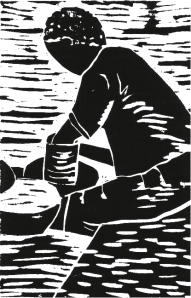
Illustration from Etched in Clay
Dave, 1815
Master says ”Dave—
That suits you.
That’s your name.”
He can call me
Whatever he pleases,
Tom or John or Will or Dave,
No matter.
I had another name once.
I can’t remember the sound of it;
But I know the voice,
smooth and soft,
that whispered it
close to my ear
in the still night.
And then
my mother was gone.
After writing several poems in Dave’s voice, I wanted to explore the other people in Dave’s life. What did they say? How did they feel? How did they relate to Dave? What about Harvey Drake, a young man sent by his uncle to purchase a slave? Was he confident in making this purchase? Did he have doubts? What about Eliza, a house slave thought to be Dave’s first wife? I cannot imagine the sorrow of their separation when she was sold and taken to Alabama. I wanted to hear from Dave’s subsequent owners: Abner Landrum, John Landrum, Reuben Drake, Lewis Miles, and BF Landrum. Lewis Miles and Dave seemed to have become friends of sorts, even joking about the way to place a handle on a clay pot. And then there was the despicable Benjamin Franklin Landrum who says “It takes a strong whip/to control these slaves.” (EIC p. 101.) After a terrible beating, Dave finds one of the slaves “…hanging limp/and her pulse is gone.”

Illustration from Etched in Clay
Multiple voices can allow the readers a glimpse into the minds of various characters. Why do they do what they do? How do they rationalize their actions to themselves and others? How do they relate to other characters? With multiple voices, the writer can create a world.
While doing the research for Etched in Clay, I read articles about Dave’s pottery and viewed photographs of his jugs. I read about the history of South Carolina and the Landrum Family that owned Dave through much of his life. I read hundreds of slave narratives. And then I drove 11 hours from Ohio to South Carolina.
While traipsing across the Carolina fields where Dave once lived and worked, it started drizzling. After a short storm, the sun came out, and I saw that the field was littered with shards of pottery, glistening in the morning light. I picked up a few shards and wondered if perhaps they were Dave’s. Then I walked downhill to the creek where Dave and others dug the clay. The water was cold and running fast. The banks were steep. I held a handful of wet clay in my hand. In the evening, at the Edgefield Inn, near Dave’s home, I wrote many of the poems in Etched in Clay. Like the shards I had seen, I hope that they create a whole.
Further Reading:
An interview with Andrea Cheng about Etched in Clay in School Library Journal
A look at how Andrea Cheng made the woodcut illustrations for Etched in Clay
Filed under:
Curriculum Corner Tagged:
Etched in Clay,
National Poetry Month,
Nonfiction poetry,
poetry,
teaching resources,
writing,
writing resources 


By:
Hannah,
on 4/1/2014
Blog:
The Open Book
(
Login to Add to MyJacketFlap)
JacketFlap tags:
nonfiction,
environmentalism,
teaching resources,
global citizenship,
Jan Reynolds,
CCSS,
diversity in the classroom,
Curriculum Corner,
informational text,
geoliteracy,
Add a tag
Today’s world is smaller than ever, and as technology continues to advance it will only get smaller. Raising students for success means teaching them how to be global citizens, emphasizing cultural literacy and geoliteracy, and exposing them to people whose lives differ from theirs.

For this, there’s no better author than Jan Reynolds. Reynolds is a writer, photographer, and adventurer who has written over fourteen nonfiction books for children about her travels. Her work has appeared in numerous publications including National Geographic, The New York Times, and Outside Magazine. Reynolds is an avid skier, mountain climber, and adventurer who holds the record for women’s high altitude skiing, was part of the first expedition to circumnavigate Mount Everest, and performed a solo crossing of the Himalayas.
Throughout April, we’ll be exploring how Jan’s books can be used in the classroom to teach about the environment, geoliteracy, global citizenship, and nonfiction. Today, we wanted to share Jan’s books and some of our favorite resources available to help teach them:

image from Cycle of Rice, Cycle of Life
Jan’s Books:
Vanishing Cultures: Sahara (North Africa)
Vanishing Cultures: Mongolia (Mongolia)
Vanishing Cultures: Himalaya (Nepal/Tibet)
Vanishing Cultures: Frozen Land (Northwest Territories, Canada)
Vanishing Cultures: Far North (Arctic Circle, Northern Europe)
Vanishing Cultures: Amazon Basin (Amazon Basin, South America)
Vanishing Cultures: Down Under (Australia)
Celebrate! Connections Among Cultures
Cycle of Rice, Cycle of Life: A Story of Sustainable Farming (Bali)
Only the Mountains Do Not Move: A Maasai Story of Culture and Conservation (Kenya and Tanzania)

image from Vanishing Cultures: Far North
Lesson Plans and Classroom Guides:
Classroom Guide for Vanishing Cultures series (including classroom guides for individual books)
Classroom Guide for Only the Mountains Do Not Move
Classroom Guide for Cycle of Rice, Cycle of Life
Classroom Guide for Celebrate! Connections Among Cultures
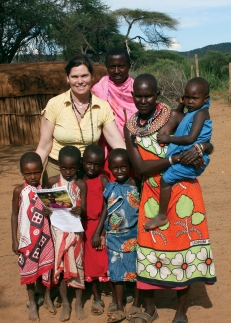
Jan Reynolds with Maasai family while working on Only the Mountains Do Not Move
Interviews with Jan Reynolds:
Jan Reynolds on Cultural Anthropology and Photography (Only the Mountains Do Not Move)
Talking about Sustainability with Jan Reynolds (Cycle of Rice, Cycle of Life)
Interview with Jan Reynolds on Celebrate! Connections Among Cultures

map of some of the places explored in Jan Reynolds’ Vanishing Cultures series
Video:
Jan! From Here to There
Maasai Life with Anthropologist Terry Mcabe
Life in the Wild: Visit a Maasai Tribe in Kenya
Explore Rice Farming on the Island of Bali: Parts I, II, and III
Author Visits:
Jan Reynolds visits schools around the world to share her books and experiences, and also does virtual Skype visits. For more information on her school visits or virtual visits, visit her website or contact us at [email protected].
Visit our Author Study Pinterest Page for more great activities and resources related to Jan’s books, and stay tuned throughout April as we delve deeper into the books of Jan Reynolds and explore how they can be used to teach global citizenship, environmental stewardship, geoliteracy, and more.
Filed under:
Curriculum Corner Tagged:
CCSS,
diversity in the classroom,
environmentalism,
geoliteracy,
global citizenship,
informational text,
Jan Reynolds,
nonfiction,
teaching resources 

We were thrilled to see the announcement this week that architect Shigeru Ban has won the Pritzker Architecture Prize, one of architecture’s most important awards. Ban is notable not only for his inspired and gorgeous designs but for his humanitarian work using innovative architecture and renewable resources to help refugees and those affected by both man-made and natural disasters. Take a look at his paper tube school in China, featured in our book Dreaming Up: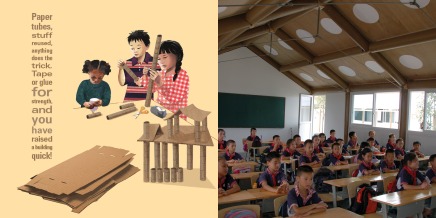
Teachers and students helped construct this temporary school out of plywood and recycled heavy-duty paper tubes after an earthquake destroyed many buildings in China’s Sichuan Province. Dreaming Up author and illustrator Christy Hale shares why she chose to include Shigeru Ban’s work in her book:
In selecting the architects and structures featured in Dreaming Up: A Celebration of Building I began by considering children’s building play. What materials do they use? Children do not need prepackaged toys; they can build from whatever is at hand. In fact using recyclables encourages two qualities enormously important in creativity: resourcefulness and flexibility—essential for the problem-solvers of tomorrow. After developing my list of children’s construction activities, I then looked for architects working with visually similar materials and design challenges. This is how I made my pairings.
The new Pritzker Architecture Prize-winner, Shigeru Ban said, “Anything can be building structure material.” Ban creates elegant designs from humble materials. He is famous for upcycling industrial strength paper tubes, shipping containers, and even tea bags!
I thought my young readers would particularly like his Paper Tube School in Chengdu, a temporary school built in 2008 with the help of teachers and students after an earthquake destroyed many buildings in China’s Sichuan Province. I also wanted to showcase Ban for his humanitarian work. His architecture efficiently serves the pressing needs of disaster victims while simultaneously honoring them with beauty.
Shigeru Ban’s approach to architecture makes a great entry point when introducing young people to the art form. Use these teaching resources along with Dreaming Up to inspire next generation of architects:
Recycled Building Hands-On Classroom Activity
Great Teaching Ideas for Dreaming Up from The Classroom Bookshelf
LEGO’s Read! Build! Play! Summer Reading List and Activity Guide
Filed under:
Curriculum Corner Tagged:
architecture,
dreaming up,
lesson plans,
Pritzker Prize,
Shigeru Ban,
teaching resources 


By: JOANNA MARPLE,
on 3/6/2014
Blog:
Miss Marple's Musings
(
Login to Add to MyJacketFlap)
JacketFlap tags:
CITY CAT,
Kate Banks,
Perfect Picture Book Friday,
picture books,
cats,
Lauren Castillo,
Europe,
teaching resources,
Cities,
Add a tag
Title: City Cat Story by Kate Banks Art by Lauren Castillo Published by Foster Books, Farrar Strauss Giroux, 2013 Ages: 5-8 Themes: cat, travel, European cities 40 pages Opening Lines: Wake up, City Cat. It’s dawn. … Continue reading →
View Next 4 Posts












 e, or what students are expected to be able to do in order to demonstrate gained knowledge. Differentation by product is valuable in encouraging student success and practice in other areas of thinking and learning.
e, or what students are expected to be able to do in order to demonstrate gained knowledge. Differentation by product is valuable in encouraging student success and practice in other areas of thinking and learning.
 task: help every student become a successful learner. How can teachers support all students’ diverse needs? Much confusion and fear have surrounded differentiated instruction and its use in the classroom.
task: help every student become a successful learner. How can teachers support all students’ diverse needs? Much confusion and fear have surrounded differentiated instruction and its use in the classroom. Myth #2: Every student should be doing something different
Myth #2: Every student should be doing something different














I have been reading to my daughter in Spanish since she was a baby (she is now four) but she occasionally rebels. Thanks for these great tips!
Reblogged this on adventureswiththepooh and commented:
If you want to read to your child in Spanish, check out these great tips!